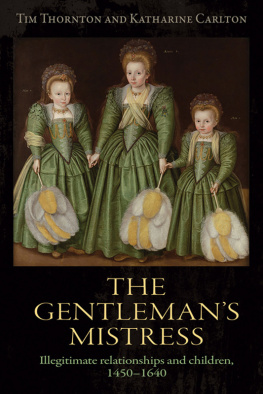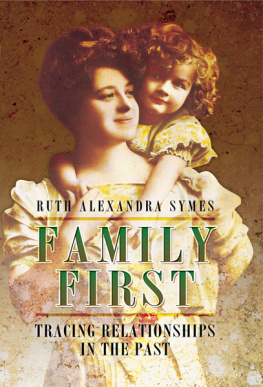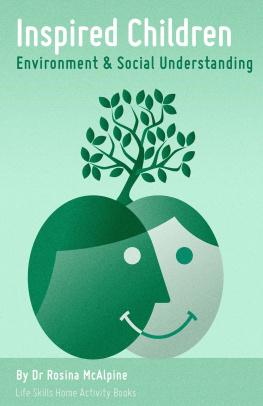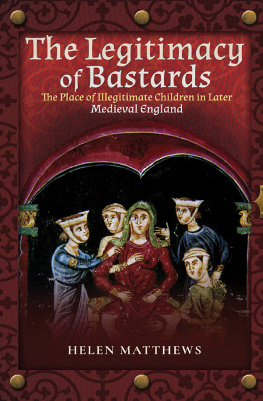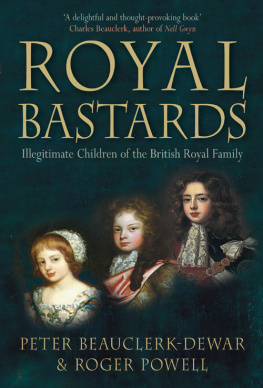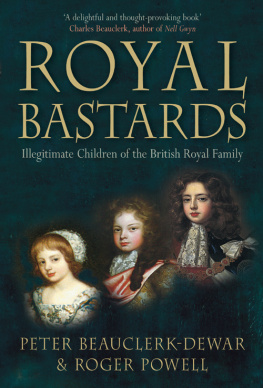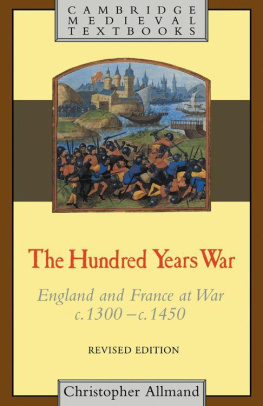The gentleman's mistress
Illegitimate relationships and children, 14501640
Tim Thornton and Katharine Carlton
Manchester University Press
Copyright Tim Thornton and Katharine Carlton 2019
The right of Tim Thornton and Katharine Carlton to be identified as the authors of this work has been asserted by them in accordance with the Copyright, Designs and Patents Act 1988.
Published by Manchester University Press
Altrincham Street, Manchester M1 7JA
www.manchesteruniversitypress.co.uk
British Library Cataloguing-in-Publication Data
A catalogue record for this book is available from the British Library
ISBN978 1 5261 1406 8hardback
First published 2019
The publisher has no responsibility for the persistence or accuracy of URLs for any external or third-party internet websites referred to in this book, and does not guarantee that any content on such websites is, or will remain, accurate or appropriate.
Typeset
by Toppan Best-set Premedia Limited
Any project of this kind is long in the making and the debts accumulated in the process are many, varied and inevitably too complex to be acknowledged in the detail they deserve. Conversations and discussions, comments and ideas have been contributed along the way by many friends and colleagues, among whom it is important, given the subject matter, to single out Chris Haigh, the late Gordon Forster and Martin Ingram. We are both fortunate to have the University of Huddersfield as a context in which to work: over the years, the warm collegiality and generous support, and the clear direction and leadership, offered by fellow historians and senior colleagues alike has been vital to the stimulation of this work. Especial mention must go to Professors David Taylor, Mike Russ, Keith Laybourn, and Vice-Chancellor Professor Bob Cryan. The book was completed in the week immediately after the University of Huddersfield won the Times Higher Education Leadership and Management Award for Outstanding Leadership and Management Team 2018, and it is one sign of the strength of the team that it could support the completion of this work in the midst of so many other exciting agendas. Many dozens of students who have been involved in modules on late medieval and early modern English social and polital history also, probably unwittingly, have played a major role, and deserve their share of the credit. None, of course, share the responsibility for any misjudgements and errors which remain.
Anyone working on a project of this kind is fortunate to have the opportunity of reading in some outstanding archives and libraries, and the staff of those particularly important to the evidence used here deserve mention: Carlisle Archive Centre (Cumbria Archive Service), Cheshire Archives; Durham University Library; West Yorkshire Archive Service in Leeds; Leeds University Library Archives and Special Collections; Leicester and Rutland Record Office; Lancashire Record Office; and Borthwick Institute for Archives at the University of York. Special thanks are also due to colleagues in Computing and Library Services at the University of Huddersfield, especially document delivery, for their unfailing patience and excellent service over the years. Much logistical and administrative support has come from Sam Arrowsmith, Claire White and Katie Baron.
Manchester University Press have provided an unusually positive and supportive environment for the completition of the work: particular thanks are due to Emma Brennan and her editorial and production team, and to anonymous reviewers for their helpful comments.
We are grateful for permission to refer to the unpublished theses of Helen Matthews, the late Jack Brierley Watson and the late Philip Tyler.
Woven through this book is the support we have received from our respective families, in their different ways: Tim Thornton is always aware how much this reflects the love, stimulation and inspiration provided by Sue Johns, Carys and Gwyn; Katharine Carlton would like to acknowledge debts to the late Edna Aynge, loving support from Jason Carlton, Alice Carlton, Robert and Vivienne Walker.
| BIA | Borthwick Institute for Archives, University of York |
| BL | British Library |
| Cheshire Arch | Cheshire Archives and Local Studies |
| CP | G. E. C[ockayne] & G. H. White, The Complete Peerage (14 vols. London & Stroud: St Catherine Press; Sutton, 191059, 1998) |
| DUL | Durham University Library |
| JRULM | John Rylands University Library of Manchester |
| LP | Letters and Papers, Foreign and Domestic, of the Reign of Henry VIII,Preservedin the Public Record Office, the British Museum, and Elsewhere in England, ed. J. S. Brewer, J. Gairdner and R. H. Brodie (London: HMSO, 18621910); Addenda, I (London: HMSO, 192932) |
| LPRS | Lancashire Parish Register Society |
| LRO | Lancashire Record Office |
| ODNB | H. C. G. Matthew and Brian Harrison (eds), The Oxford Dictionary of National Biography (61 vols. Oxford: Oxford University Press, 2004) |
| RSLC | Record Society of Lancashire and Cheshire |
| TE | Testamenta Eboracensia, A Selection of Wills from the Registry at York, parts IIVI, ed. J. Raine and J. W. Clay, Surtees Society, XXX, XLV, LIII, LXXIX, CVI (1855, 1865, 1868, 1884, 1902) |
| TNA | The National Archives of the United Kingdom |
| VCH Lancs | W. Farrer and J. Brownbill (eds), The Victoria History of the Counties of England: The Victoria History of the County of Lancaster (8 vols. London: [A. Constable], 190614) |
| YASRS | Yorkshire Archaeological Society, Record Series |
All dates have been given new style with the year beginning on 1 January. Abbreviations have been silently expanded and punctuation modernised.
By focusing upon narrow geographical and social boundaries, historians imply that bastardy became a lifetime stigma from which neither mother nor child could escape and, as a result, they do not explore illegitimacy patterns at gentry level and above. Keith Wrightson and David Levine's path-breaking investigation of illegitimacy in the Essex parish of Terling in the period 15901640 identified only one man of gentry status fathering an illegitimate child out of a total of fifty putative fathers. Richard Adair's outstanding survey of illegitimacy in the parishes of early modern England makes only the briefest of passing mentions of elite involvement in bastardy, essentially in the form of the results of rape or coercion of lower-class women by gentlemen. Yet concern at the extent of sexual relationships outside marriage, and of the extent of bastardy arising from it, was not necessarily limited to commentators on the state of the poor and disadvantaged in parish society. And even the most cursory survey of those who exerted power and influence in late medieval and early modern England quickly reveals the names of men (and some women) of dubious parentage or questionable fidelity. Approximately one in ten gentlemen who made wills during the period in the north of England made some mention of illegitimate offspring, suggesting that illegitimate relationships and children were to be found in at least 10 per cent of gentle families. The illegitimate offspring of gentry and noble families participated in office-holding and local government, and their marriages formed part of the social landscape of the period.

